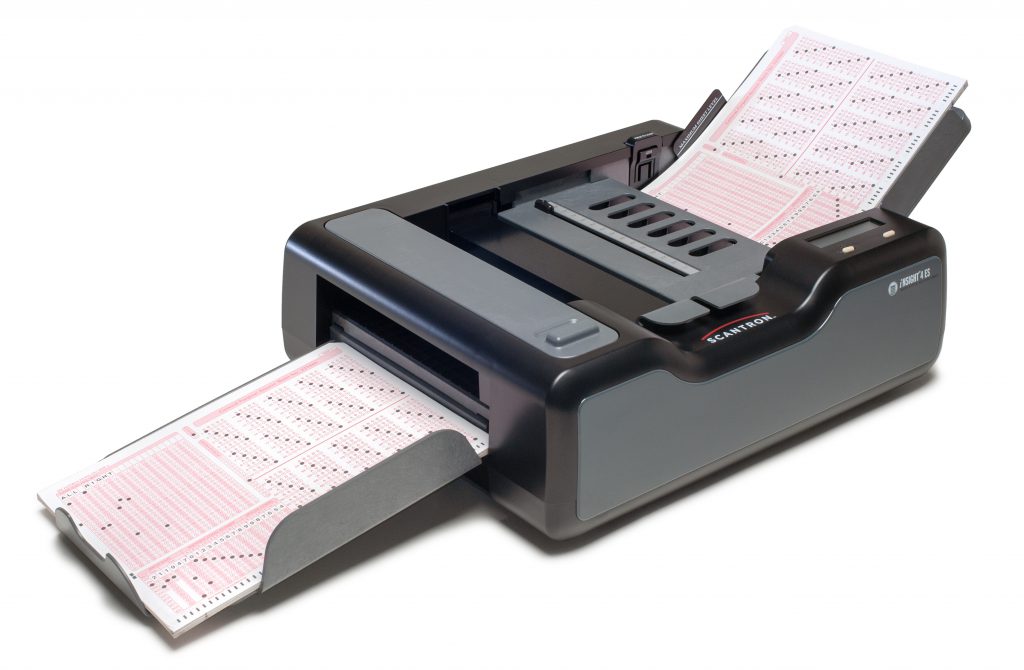

Product Overview
- Reads traditional OMR “bubble” marks.
- Captures image clips of text areas or text boxes, such as essay responses on a test or comment fields on a survey.
- Captures images of full pages.
- Captures and converts written information into digital information with ICR technology – such as name, address, and identification number.
- Reads both pen and pencil forms.
- Reads checkbox responses, X box responses, and bar codes.
Accurate, Fast and Efficient
The iNSIGHT 4ES scanner is accurate, fast and efficient. It has a form throughput rate of up to 2,800 sheets-per-hour and a fixed, automatic feed hopper that holds 100 sheets and helps eliminate continual form reloading and constant operator attention.
Using continuous self diagnostics, the iNSIGHT 4ES alerts you when it detects conditions that may affect data accuracy. The scanner’s sheet thickness detector helps ensure the scanner reads only one sheet at a time and the sheet-skew detection helps ensure proper registration while scanning.
The iNSIGHT 4ES is energy efficient and reduces power consumption when not in use.
Easy to Operate
The iNSIGHT 4ES scanner is easy to operate and reads both pencil and pen marks from an OMR form, giving you the most precise and effective data available. Messages are provided on a forty-character display to simplify operation. An open feed path provides sheet visibility at all times as well as easy access for sheet removal and transport cleaning. The scanner self-diagnostics quickly pinpoint any operating problems.
Software applications developed for the iNSIGHT 2/3/4/4U and ScanMark™ ES 2010, 2260, and 2800 scanners are plug-and-play compatible with the iNSIGHT 4ES scanner. All iNSIGHT 4ES models include a Scantron Score emulator to support scanning Test Scoring machine forms.
Eliminates Extra Steps
The iNSIGHT 4ES is designed to lighten your workload, enabling you to:
- Readily share documents online with colleagues – such as tests to be graded by a group of teachers. This powerful feature eliminates the cumbersome task of photocopying, distributing, and collecting paper copies.
- Create electronic archives for a paperless “paper trail” – a convenient and reliable alternative to paper records that can degrade over time.
- Simplify the process for users in providing demographic information – with intelligent character recognition (ICR) technology that converts hand-print to electronic text.
What’s the difference between pencil read and ink read?
A lot of scanners claim to read both pencil and ink marks, including us. But not all scanners support both pencil and ink forms. Due to the type of light source used to recognize marks, pencil forms can be very colorful, since the read-head will only recognize the pencil marks on those forms—the color of the form doesn’t matter. Pencil forms are often more visually engaging, but you lose the ability to support ink responses. On the other hand, ink forms use what’s known as a drop out color (usually some type of red or orange). That way, the scanner can ignore anything that’s red or orange, letting it read either pencil or ink marks from the form.
Why does this matter?
It matters because scanning accuracy depends on the read-head and processing software knowing what is part of the form and what is a mark. Scantron’s guaranteed scannable forms and industry-leading mark recognition software ensure that you get the same reliable results, regardless of which type of form you use.
Suggested Uses
Testing and Training
- Tests and learning assessment
- Instructor, performance, and course evaluations
- Enrollment and tracking
- Student profiles, documentation, and forms
Research and Evaluation
- Survey and questionnaire data collection
- Product research
- Program evaluations
- Competitive data collection
- Enrollment and applications
Human Resources
- Payroll/time sheets
- Benefit enrollments
- Applicant tracking
- Employee change of status
- Employee surveys
- 360-Degree surveys
Healthcare
- Patient encounter forms
- Patient satisfaction surveys
- Medical histories and patient forms
- Patient, needs and risk assessments
- Nurse staffing reports
- Continuing education evaluations
| Physical Description | Length: 21.25” Width: 14.5” Height: 9” Weight: 17 lbs |
| Environment | Operating Temperature: 60° to 85°F (16°C to 29°C) Humidity: 40% to 60%, non-condensating |
| Power | 100-240 volt operation: 100-240 volts AC (-10%, +6%): 50-60 Hz; US 3-prong plug; 15 amp dedicated circuit |
| Communications | USB 2.0 connection—Image or OMR processing |
| Operation | Dual Read Heads: 200 dots per inch (dpi) resolution, up to 256 levels of grayscale per pixel; pencil and ink read capabilities Pencil or ink forms may be used Scanning Rate: 2,800 sheets per hour in OMR mode, 2,300 sheets per hour in OMR with imaging mode Forms: 2.5” x 5” to 9” x 14” (60-100 lb. Offset). Uses both Mark Reflex B and Trans-Optic® forms Form Input Capacity: Auto-feed, 100 sheets Output Stacker Capacity: 100 sheets main stacker, 100 sheets select stacker (if present) Controls: Two Push button programmable switches Message Display: 40 character, alphanumeric Multi-feed detection Integrated ES/ScanMark™ Emulation Mode |
| Options | A programmable interactive printer Select stacker separates forms that fail edit checks Bar code reader SelfScore® option for classroom test scoring and surveys |
PC Hardware
- Pentium® processor: 1 GHz 32-bit (x86) or 64-bit (x64) minimum
- System memory: 1 GB minimum
- Hard drive space: 40 GB hard drive with at least 15 GB of available space
- Monitor at 1024 x 768 or higher resolution
- CD-ROM drive (for installation)
- USB 2.0 connection— Image or OMR processing
Operating Systems
- Windows 10 64-bit operating systems, with all hotfixes and service packs installed.

